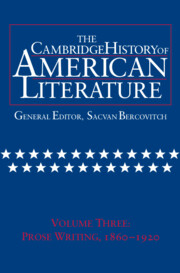Book contents
- Frontmatter
- Introduction
- THE AMERICAN LITERARY FIELD, 1860–1890
- LITERARY FORMS AND MASS CULTURE, 1870–1920
- 1 Museum Realism
- 2 Howells, James, and the republic of letters
- 3 Women and Realist authorship
- 4 Chesnutt and imperial spectacle
- 5 Wharton, travel, and modernity
- 6 Adams, James, Du Bois, and social thought
- PROMISES OF AMERICAN LIFE, 1880–1920
- BECOMING MULTICULTURAL: CULTURE, ECONOMY, AND THE NOVEL, 1860–1920
- Chronology 1860–1920
- Bibliography
- Index
4 - Chesnutt and imperial spectacle
from LITERARY FORMS AND MASS CULTURE, 1870–1920
Published online by Cambridge University Press: 28 March 2008
- Frontmatter
- Introduction
- THE AMERICAN LITERARY FIELD, 1860–1890
- LITERARY FORMS AND MASS CULTURE, 1870–1920
- 1 Museum Realism
- 2 Howells, James, and the republic of letters
- 3 Women and Realist authorship
- 4 Chesnutt and imperial spectacle
- 5 Wharton, travel, and modernity
- 6 Adams, James, Du Bois, and social thought
- PROMISES OF AMERICAN LIFE, 1880–1920
- BECOMING MULTICULTURAL: CULTURE, ECONOMY, AND THE NOVEL, 1860–1920
- Chronology 1860–1920
- Bibliography
- Index
Summary
NATIVE AMERICAN LETTERS AND GERONIMO'S BOOK
The birth of an American mass-culture industry in the decades 1850–90 coincided with the “Long Death” of free Native-American peoples in the trans-Mississippi West. There was no strict causal connection; mass culture was predicated on explosive population growth and new technologies, yet even with these advantages there was nothing fated about the US dispossession of “Indian Country,” which commenced soon after the Great Plains were promised to indigenous peoples at mid-century. But the conjunction in time created a certain reciprocity between the two events: the rise of mass culture is also a fitful record of the subjugation of free Native-American cultures. Mass portrayals of Native Americans form an erratic archive that is less self-serious but no less revealing than the ideological arguments or “metaphysics of Indian hating” Herman Melville sardonically identified as a national creed. Alongside demonstrations of contempt and enmity for Native Americans, mass culture enacts strains of awe, guilt, compassion, and envy never reflected in US military campaigns and policies. As regards Native Americans – and conflicted race questions broadly in the period – mass culture is the troubled unconscious mind of the white body politic, harboring desires and fears that take public shape through routes of contradiction and denial. In its new spaces of virtual existence, from photographs, dime novels, and Wild West shows to its apotheosis in the cinema, mass culture creates an expanding iconic life for Native Americans as they are steadily dispossessed of their lands and free lives.
- Type
- Chapter
- Information
- The Cambridge History of American Literature , pp. 181 - 223Publisher: Cambridge University PressPrint publication year: 2005

